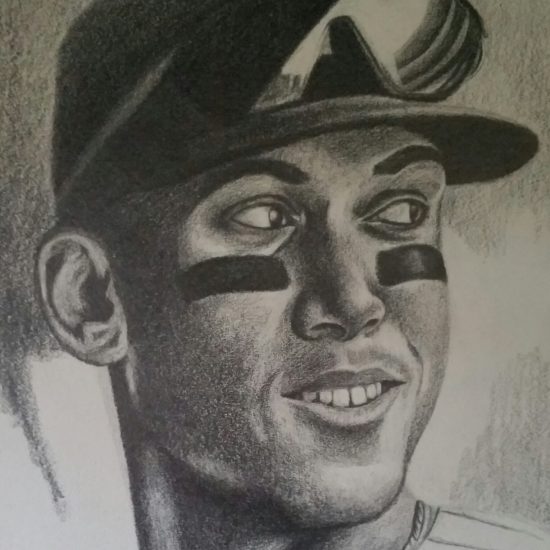We’ve seen plenty of rookies make their marks in 2024 with the likes of Paul Skenes, Jackson Chourio, and James Wood. However, with the season concluding, let’s spotlight five veterans who have put fantasy teams on their backs with unforgettable performances.
If you’re new to PLV, you can find Nick’s primer here.
Note: Stats and PLV data are current through Monday, September 16th.
After posting a .304 wOBA and 78 wRC+ with the Rockies and Padres last season, chances are many people didn’t give Profar a second thought when he signed a one-year, one-million-dollar deal with the Padres this past February. But alas, a scant 12 years after Baseball America named him the best hitter in the minors, El Patron reminded us once again of the axiom that prospect growth isn’t linear by posting a .370 wOBA and 143 wRC+, shattering his previous highs of .341 and 107 in 2018, his final year in Texas.
Profar has always demonstrated exceptional contact ability and made pretty sound swing decisions last season (111 DV) too despite the lack of results. This year, though, Profar’s power surged from well over a standard deviation below average (81) to… just about average (98). At face value, the average-ish power doesn’t seem like much but Profar’s above-average contact ability (107) and excellent swing decisions (114 DV) turned him into a force to be reckoned with. Great results aside, he more or less did everything you want to see from a good hitter.

In total, his Process+ climbed from 91 last year to 109. (For an explanation of the Process+ hitting metric, check out Nate Schwartz’s article). Unfortunately, we’ve seen his power dip lately just in time for the fantasy playoffs (doesn’t it always happen that way?). Regardless, he’s been a remarkable contributor really for the entire season.
The D-backs offense has been one of the underappreciated stories of the season. Through Tuesday, September 17th, they lead baseball with 826 runs scored; the Dodgers are second (760) followed closely by the Yankees (758). And the Snakes are first in team wOBA at .336. How about that?
Eugenio Suárez is a huge reason why they’ve been so good. The righty third baseman is just two shy of his fifth 30 HR season and has really helped to pick up the slack when Ketel Marte went down with an ankle injury in mid-August. After reaching the break hitting .216 with 10 home runs across 93 games, he’s hit .316 with 18 home runs in the second half (53 games). Talk about a second-half surge.
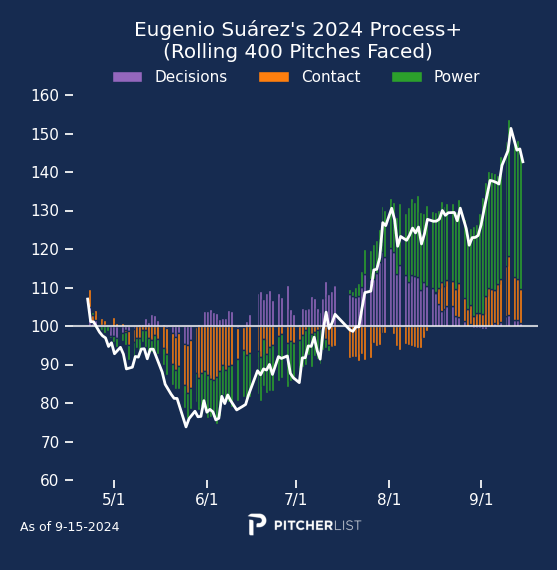
Much like Profar, Suárez entered 2024 as an afterthought after a down season prompted the Mariners to ship the 32-year-old slugger to Arizona in exchange for RP Carlos Vargas and catcher Seby Zavala. Hindsight being 20/20, you have to wonder if the Mariners would opt for a do-over given their offensive shortcomings being a big reason behind their falling out of the playoff picture.
Regardless, Suárez and his .340 wOBA and 96 RBI (15th in MLB) have the D-backs poised for what would be just their second consecutive postseason berth in franchise history. The other came as defending champs when the Red Birds swept them in the 2002 NLDS. Meanwhile, thrifty fantasy managers were able to pluck a Top-10 third baseman (currently eighth according to Yahoo 5×5 scoring) off the wire in many leagues.
Suárez has long had an affinity for barrels thanks to his penchant for pulled fly-balls and this year has been no different (111 power). However, a near five-point dip in Suárez’s strikeout rate has helped fuel his monster season. Sure enough, his contact ability has gone up from 82 last year to 91 thanks in part to his swinging more often than ever; his 47.2% swing rate being the highest of his 11-year career. PLV’s swing aggression is another way to look at it, with his increasing from -5.7% to -2.4%.
2,730 Pitches | 5.08 PLV
Selected 34th overall by the Royals out of Indiana State in 2013, Manaea has had some moments over the years, none bigger than his no-no against the eventual World Series Champion Boston Red Sox in 2018. Remember that? He entered 2024 with a respectable 4.10 ERA and 1.22 WHIP across 1002.2 IP. Not bad at all, but certainly not unforgettable.
Last season with the Giants, Manaea posted a ho-hum 4.44 ERA and 1.24 WHIP across 117.2 IP, while logging considerable time in the pen (he made just 10 starts). However, he managed a 25.7% K rate, matching his career-high from 2021. In hindsight, maybe there was something to that. Either way, Manaea, was more or less an afterthought come draft day; a late-round flier in deep leagues who was, at one point, widely available off the wire in standard-sized leagues. If you took the plunge you were rewarded, not with a decent streamer, but with an anchor for your pitching staff (ranked 55th in Yahoo standard 5×5) who has lived up to his puissant sobriquet, AKA the Manaealator en route to a career-best 3.26 ERA. Plus, he’s 20th with 171 IP, and 25 outs away from matching his personal best.
Let’s glance at the 32-year-old lefty’s bread and butter, the sinker (43.4% thrown). At first blush, it looks rather ordinary averaging 92 mph with a 5.02 PLV putting it into the 53rd percentile among SP. His sinker’s induced vertical and horizontal break are also right in the meat of the curve (55th and 57th percentile among SP, respectively).
But then you might’ve noticed his sinker has also netted an 11% SwStr rate. That’s exceptional for a sinker, ranking in the 95th percentile among SPs. And Manaea loves to live upstairs.
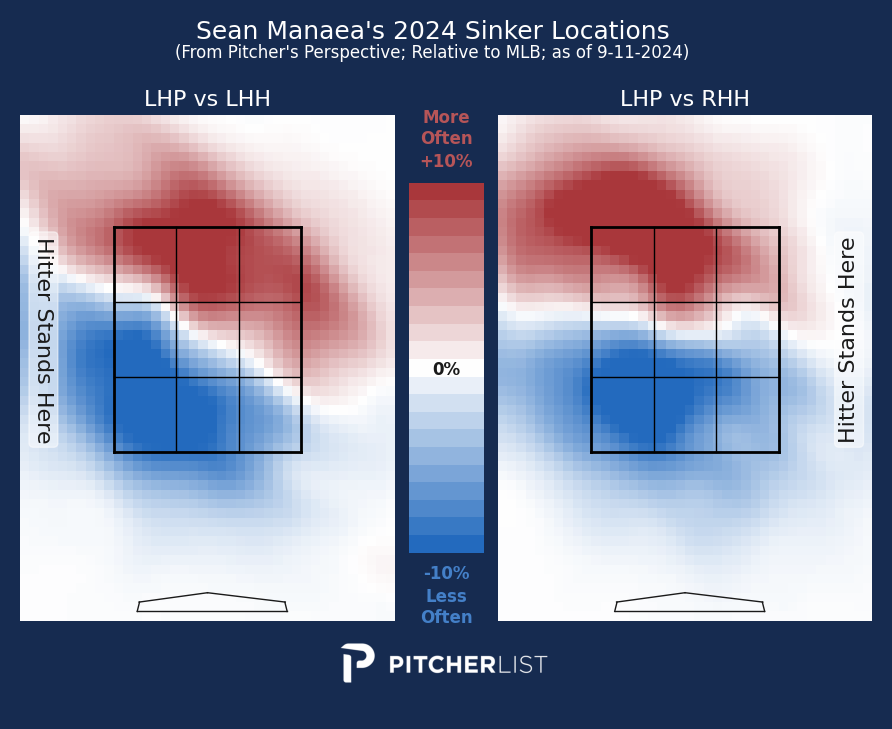
That’s a remarkable dichotomy. It almost looks a little like a flag, no? Sure enough, his sinker’s hiLoC% ranks in the 99th percentile. Manaea threw primarily four-seamers last year with the Giants while similarly attacking hitters atop the zone, although his pitch locations weren’t quite as divided (88th percentile hiLoC% with his four-seamer).
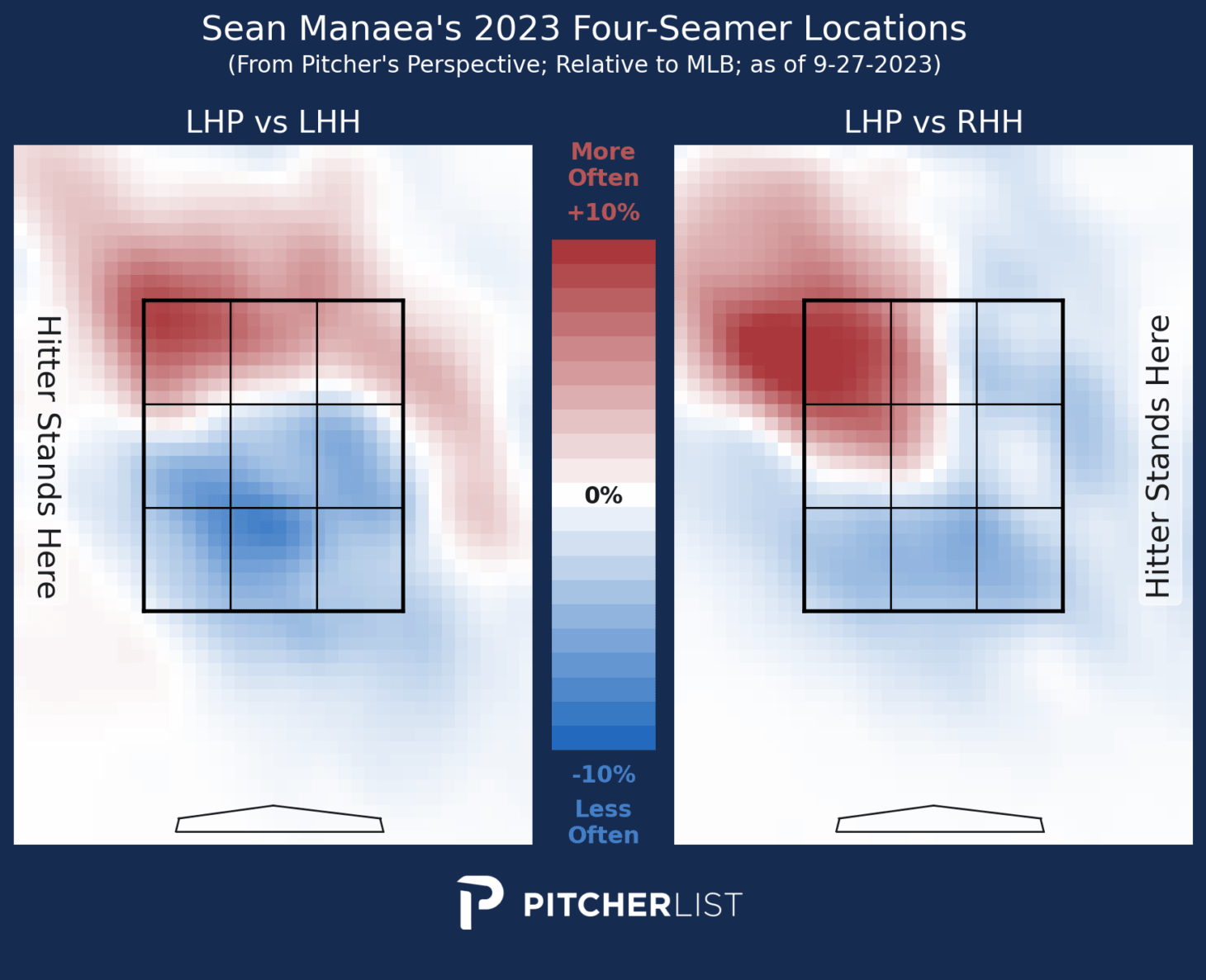
Manaea’s extension (7.2 feet) also ranks in the 96th percentile and so does his vertical approach angle. However, when adjusted for height (Nick doesn’t call him the baby giraffe for nothing) his VAA comes down a bit to the 69th percentile.
Back in April, Lucien Kisch took a closer look at Manaea and noticed a difference in his batted ball profile. Sure enough, Manaea’s groundball rate has plummeted from 46.3% to 38.7%, despite more or less swapping his four-seamer for a sinker. Of course, these are only details illustrating his success. The actual crux behind Manaea’s renaissance probably lies behind him altering his arm slot. Either way, the statuesque, left-hander cuts a unique profile. Not that you needed more numbers to believe in his increased ability to befuddle hitters. The fact that, you know, it’s football season and he’s still humming along suggests there’s bonified chicanery afoot.
2,891 pitches | 5.11 PLV
We go from a current to a former Met in Seth Lugo who has also been around a long time having debuted in 2016. Lugo has always shown intriguing ability but had trouble avoiding injuries and found himself shoehorned into a bullpen role for much of his career. However, last season he got his chance at a gig in the rotation with the Padres and tossed a career-best 146.1 IP across 26 starts after not having started more than 18 games which he did back in 2017. Here we are a year later, and the soon-to-be-35-year-old leads baseball with 197.2 IP and 16 wins. For my money, Lugo’s transformation into a workhorse starter after all these years is one of 2024’s best baseball stories.

As you might have known, Lugo’s arsenal is a bit like Yu Darvish, in that he has a pitch for nearly every occasion. But of course, the eclectic right-hander’s best offering is the curveball which this season has yielded a career-best 15.7% SwStr rate. Lugo’s curveball is extraordinarily unique featuring -16.9 inches of induced horizontal break (98th percentile) and has mitigated enemy batters to a miserly .193 xAVG and .237 xwOBA. All told he possesses a pretty amazing combo of control (5.9% BB) and command, the latter evinced by a quick look at his masterful curveball locations to either side of the plate.

Last, but certainly not least, we have Brent Rooker, who is fifth in baseball with a .403 wOBA. Yes, the very same Brent Rooker whom the Royals unceremoniously DFA’d two offseasons ago. I’ll admit, I probably should have paid closer attention to Rooker’s 30 dingers a year ago. Sure enough, PLV graded his power at 126, nearly two standard deviations above the norm. Alas, I wasn’t the only one caught sleeping on Rooker’s impending greatness as he carried an NFBC ADP of 285 this past draft season.
This season, Rooker has ratcheted up his power to further heights (139) trailing the likes of only Aaron Judge (161), Shohei Ohtani (152), Juan Soto (145), Marcell Ozuna (142), and Giancarlo Stanton (141) among hitters with at least 1,500 pitches faced. Rooker’s swing decisions have been slightly below average (96 DV). Nevertheless, he has added such a silly amount of power that we’ve seen his Process + leap from 112 to 132.
Like Suárez, Rooker’s contact ability is a weakness he has mitigated (82 last year; 94 this year) by swinging more often with his swing aggression rising from -3.6% to 2.0% (ie swinging more often than expected based on location). His heat maps illustrate his evolution. What a difference a year makes.
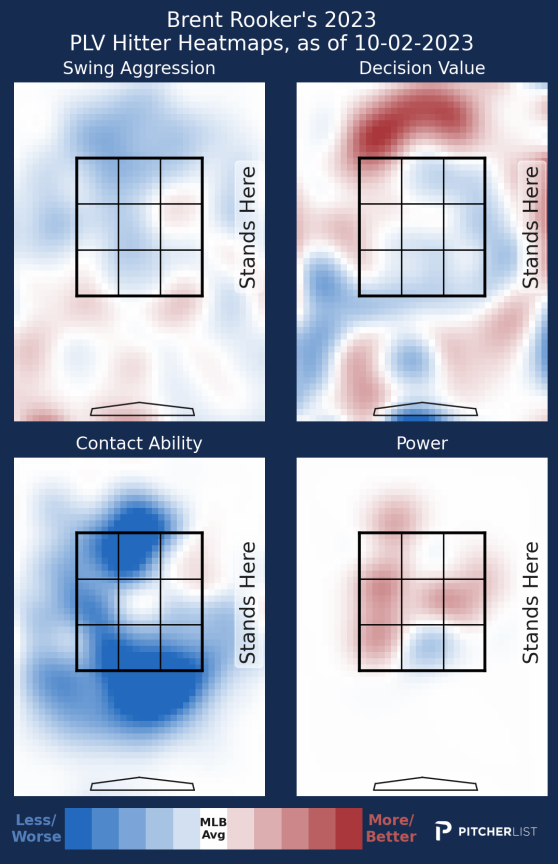
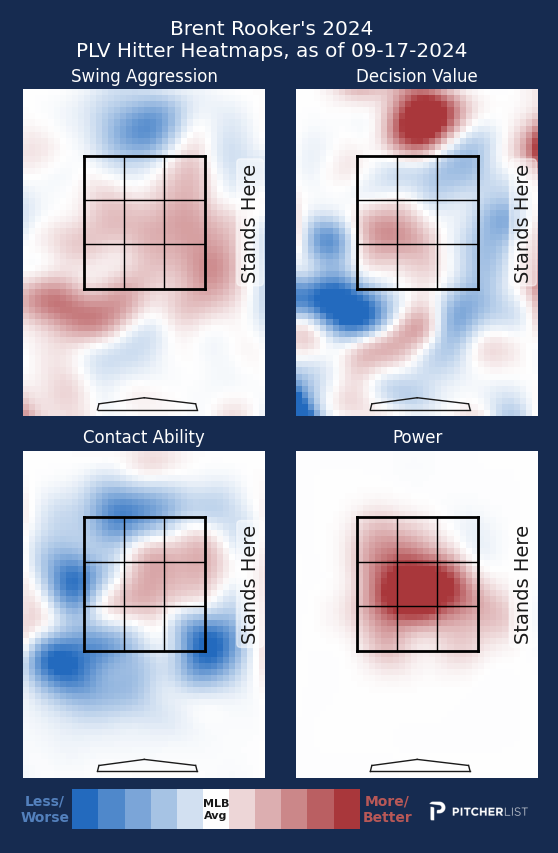
Photo by Melissa Tamez/Icon Sportswire | Featured Image by Ethan Kaplan (@DJFreddie10 on Twitter and @EthanMKaplanImages on Instagram)

